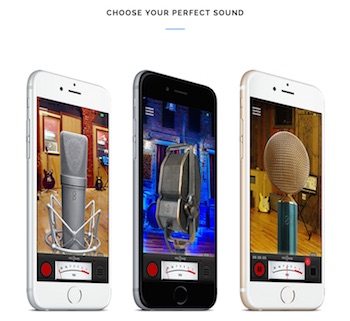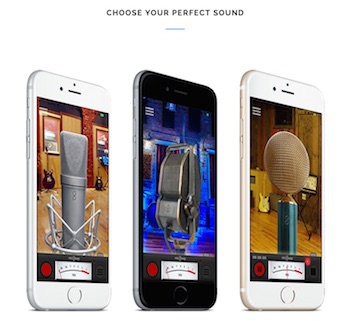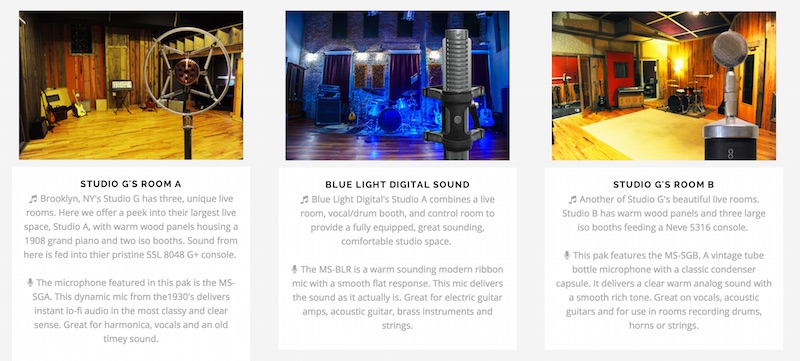 Have you ever wondered why recording studios and music venues have such a wide array of microphones in different shapes and sizes? The answer is that microphone choice can have a powerful impact on the musical sound recorded, and an exciting new mobile app called MicSwap puts that power in your hands!
Have you ever wondered why recording studios and music venues have such a wide array of microphones in different shapes and sizes? The answer is that microphone choice can have a powerful impact on the musical sound recorded, and an exciting new mobile app called MicSwap puts that power in your hands!
For any musician pursuing audio ear training, understanding the frequency effects of microphones is essential. MicSwap is primarily designed to help with music production when you’re recording a new song, but it can also be a fun and easy way to start tuning your ear into the differences between popular microphones.
 Cayla says:
Cayla says:
“Lacking that genuine feeling when you record yourself on a phone, computer, or iPad? You won’t have that problem anymore with MicSwap! Their very user friendly interface allows you to feel in complete control of your recording. From the microphone to the background, it’s customizable to offer a great, high-quality experience.
Once you’re done recording, your files are stored automatically in an easily accessible folder. From the folder you have the ability to crop and edit your music as well as do my favorite thing: change the background colors. You’re then able to sort by various details including duration, date, color, etc. Sorting by color comes in handy for coding various notes, chords, and scales for use in ear training. After you’ve created your piece, you can instantly share via various outlets including SoundCloud, email, Facebook and more. MicSwap definitely puts a new spin on the classic microphone.”
We invited Gary Levitt and Rob Behnke, the creators of MicSwap, to join us here on the site to tell us more…
Gary is a musician and recording engineer. He’s the owner of Young Love studio in Brooklyn NY. As a musician, his band Setting Sun has toured internationally several times. He’s also a standup comic performing regularly around NYC.
Rob is a musician and entrepreneur. At the time he and Gary started up this software venture Rob was exiting The Brooklyn Salsa Company, an organic food startup he cofounded. Rob records under the moniker “The Blue and Red”.
MicSwap is a swiss army knife-style application for a musician, meaning it has several tools.
First and foremost it’s a recorder where you can record your ideas and rehearsals. It can also be used in the studio as a plugin, easily giving you different vocal or guitar sounds while recording into your DAW.
You can also import audio and run it through different microphones so they act as filters. You would do this to quickly change the sound of a snare, guitar or vocal etc..
You also have the option in the settings menu to rearrange the order of the microphones so, if you’re using the app live and wanted a different sound for the chorus, you could arrange these side-by-side in advance.
As of the latest update MicSwap Pro also supports AudioBus and Inter-App Audio. That means it can be connected to all sorts of other audio apps, opening up even more possibilities.
Choice of microphone makes a big difference. Sometimes it’s conscious, sometimes not, but it’s always noticeable on a subliminal level. Listeners pick up on a warmth or a harshness even though it may not be conscious, they feel it inherently.
Choice of microphone makes a big difference. Sometimes it’s conscious, sometimes not, but it’s always noticeable on a subliminal level.
From a mixing perspective it’s important to have different microphones because it helps keep sounds separated in a mix. Much like different textured brushes provide dynamics on a canvas, microphones are like those brushes and the instruments used are the colors.
Besides having used these mics hands-on in recording studios, we got all the information we could along with frequency charts, and did our best to replicate each mics individual characteristics. Of course, it’s not the real thing, it’s an emulation, and there’s many variables that make a U47 sound like a U47, for example. After all, that mic costs over $8000 – our “U47” costs 99 cents!
As a user, it puts you inside each recording studio environment, in different rooms. As you swap mics you start to move around the room. Right now we have 2 different studios and 3 different rooms. We hope to get some classic studios involved like Abbey Road and Electric Ladyland. That’s one of our goals with the app.
Because we have a monitor and gain knob, we saw our musician friend Jennifer Turner record a vocal part with controlled feedback by cranking the gain knob with the monitor on and overloading the recording in a beautiful way. It was very cool. Like a Jimi Hendrix guitar solo played by her voice through MicSwap.
One thing we think is usually good is to record a song very soon to when it was written so you capture the original intent and emotion of the song.
Everyone is different and some recordings sound amazing but lack passion, and some have the passion but don’t sound great so it’s hard to make an empirical statement. One thing we think is usually good is to record a song very soon to when it was written so you capture the original intent and emotion of the song.
Then again, sometimes a song needs to marinate and can take a while to blossom. We think it’s safe to say to avoid all blanket statements!
Thanks to Gary and Rob for joining us here at EasyEarTraining.com and sharing some more details on this fantastic new iOS app. You can learn more at MicSwap.com or download MicSwap for free in the App Store now!











